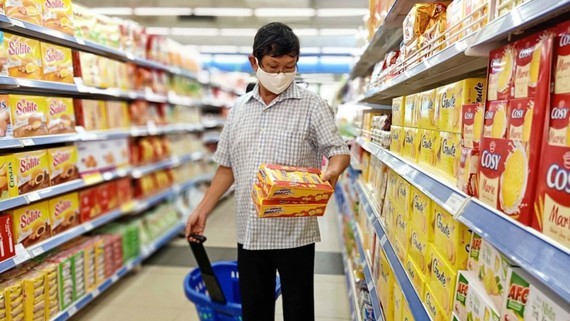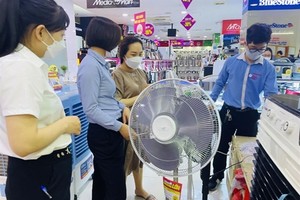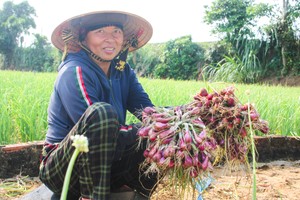
Concerns over increasing competition
Since the beginning of August this year, the EU-Vietnam Free Trade Agreement (EVFTA) has become effective. With the strong market-opening commitments, import tariffs on several high-quality products, including cosmetics, medicines, and foodstuffs, of the EU imported into Vietnam will be reduced to zero percent under the EVFTA’s schedule.
In an assessment by the European Chamber of Commerce in Vietnam (EuroCham), when the EVFTA takes effect, EU exports to Vietnam will increase by about 29 percent by 2035, equivalent to about 15 billion euros. This shows that only goods imported from the EU create intense competition for Vietnamese goods in the domestic market, not to mention that goods from other countries, such as the US, Japan, Thailand, and China, will continue to land in Vietnam. Meanwhile, consumers increasingly want to use high-quality products with eye-catching designs and competitive prices, thus Vietnamese enterprises are put under more pressure.
At present, Vietnamese products are still appreciated and given priority in the structure of goods displayed on the shelves by distributors and retailers. According to a recent assessment by the Domestic Market Department under the Ministry of Industry and Trade (MoIT), the proportion of Vietnamese goods in modern distribution networks maintains at a high level. Particularly, Vietnamese goods in Co.opmart supermarkets account for 90-93 percent, in Satra 90-95 percent, Vinmart 96 percent, Vissan 95 percent, and Hapro 95 percent. As for foreign distribution channels, the proportion of Vietnamese products also account for 65-96 percent. However, this does not mean that Vietnamese products will not have to compete with imported ones. For instance, as for fruits, it is not difficult to find exotic fruits, including apples, grapes, pears, cherries, blueberries, and oranges, in supermarkets and convenience stores across the country. Of which, as for the US market alone, the representative of the Vietnam Fruit and Vegetable Association said that in the first four months of this year, the import turnover of vegetables and fruits from the US to Vietnam exceeded US$102.1 million, up nearly 44 percent over the same period last year.
Improving competitiveness amid integration
For the EU market, the current situation of the Covid-19 pandemic in these countries is still complicated, so it is not possible to assess the impact of the implementation of the EVFTA comprehensively. However, experts said that in the post-Covid-19 period, high-quality goods from the EU will increase their presence in the Vietnamese market. Therefore, experts said that when the schedule for tax reduction in the EVFTA completes, each industry and each enterprise must have specific strategies to dominate the market. For example, the food industry will experience fierce competition with imported products from the EU, so improving production capacity, ensuring quality based on applying modern technology, and restructuring production will be effective solutions for adaptation.
Currently, food companies, namely Vissan, Ba Huan, and Saigon Food, are extremely active in strengthening their competitiveness. At the shareholders meeting held last June, Mr. Nguyen Phuc Khoa, Chairman of Vissan, said that the company was speeding up the implementation of the relocation and technological innovation of the Vissan slaughtering and food processing plant project. Moreover, Vissan has launched 10 new products, and successfully improved 16 products to improve quality and reduce cost prices. At the same time, Vissan has also been expanding online sales channels, helping customers feel secure and comfortable choosing to buy the company's products conveniently and quickly.
In the field of vegetables and fruits, the promotion of production under the VietGAP and GlobalGAP standards, as well as efforts to bring goods into domestic distribution networks, is being actively accelerated by provinces and enterprises. Up to now, vegetable products under the VietGAP standards in provinces, such as Dong Thap, Long An, Can Tho, Lam Dong, are having a stable consumption because the Saigon Co.op has pledged to ensure consumption in its whole network. This retailer also orders rice, fruit, and fish producers to follow the new set of technical standards for the group of fresh food products announced by the Saigon Co.op at the end of last year. Similarly, as for fashion products, footwear, cosmetics, and pharmaceuticals, domestic enterprises, consisting of clothing manufacturer Canifa, Minh Tien Garment Company Limited (Miti), footwear producer Biti's, Saigon Cosmetics Company, and Hau Giang Pharmaceutical Joint Stock Company, have made obvious improvements in changing models to meet both the demand for aesthetics and product quality of consumers.
Along with the above solutions, experts recommended that for enterprises, besides improvements on quality, design, and cost reduction to help their products to easily approach domestic consumers, they need to have the sense of trademark protection, which are their intellectual property, by immediately registering for the protection of intellectual property rights at the National Office of Intellectual Property of Vietnam. For trademarks that have registered for exclusive protection, enterprises need to provide information for customers to distinguish counterfeit and fake goods to avoid being taken advantage of.
Since the beginning of August this year, the EU-Vietnam Free Trade Agreement (EVFTA) has become effective. With the strong market-opening commitments, import tariffs on several high-quality products, including cosmetics, medicines, and foodstuffs, of the EU imported into Vietnam will be reduced to zero percent under the EVFTA’s schedule.
In an assessment by the European Chamber of Commerce in Vietnam (EuroCham), when the EVFTA takes effect, EU exports to Vietnam will increase by about 29 percent by 2035, equivalent to about 15 billion euros. This shows that only goods imported from the EU create intense competition for Vietnamese goods in the domestic market, not to mention that goods from other countries, such as the US, Japan, Thailand, and China, will continue to land in Vietnam. Meanwhile, consumers increasingly want to use high-quality products with eye-catching designs and competitive prices, thus Vietnamese enterprises are put under more pressure.
At present, Vietnamese products are still appreciated and given priority in the structure of goods displayed on the shelves by distributors and retailers. According to a recent assessment by the Domestic Market Department under the Ministry of Industry and Trade (MoIT), the proportion of Vietnamese goods in modern distribution networks maintains at a high level. Particularly, Vietnamese goods in Co.opmart supermarkets account for 90-93 percent, in Satra 90-95 percent, Vinmart 96 percent, Vissan 95 percent, and Hapro 95 percent. As for foreign distribution channels, the proportion of Vietnamese products also account for 65-96 percent. However, this does not mean that Vietnamese products will not have to compete with imported ones. For instance, as for fruits, it is not difficult to find exotic fruits, including apples, grapes, pears, cherries, blueberries, and oranges, in supermarkets and convenience stores across the country. Of which, as for the US market alone, the representative of the Vietnam Fruit and Vegetable Association said that in the first four months of this year, the import turnover of vegetables and fruits from the US to Vietnam exceeded US$102.1 million, up nearly 44 percent over the same period last year.
Improving competitiveness amid integration
For the EU market, the current situation of the Covid-19 pandemic in these countries is still complicated, so it is not possible to assess the impact of the implementation of the EVFTA comprehensively. However, experts said that in the post-Covid-19 period, high-quality goods from the EU will increase their presence in the Vietnamese market. Therefore, experts said that when the schedule for tax reduction in the EVFTA completes, each industry and each enterprise must have specific strategies to dominate the market. For example, the food industry will experience fierce competition with imported products from the EU, so improving production capacity, ensuring quality based on applying modern technology, and restructuring production will be effective solutions for adaptation.
Currently, food companies, namely Vissan, Ba Huan, and Saigon Food, are extremely active in strengthening their competitiveness. At the shareholders meeting held last June, Mr. Nguyen Phuc Khoa, Chairman of Vissan, said that the company was speeding up the implementation of the relocation and technological innovation of the Vissan slaughtering and food processing plant project. Moreover, Vissan has launched 10 new products, and successfully improved 16 products to improve quality and reduce cost prices. At the same time, Vissan has also been expanding online sales channels, helping customers feel secure and comfortable choosing to buy the company's products conveniently and quickly.
In the field of vegetables and fruits, the promotion of production under the VietGAP and GlobalGAP standards, as well as efforts to bring goods into domestic distribution networks, is being actively accelerated by provinces and enterprises. Up to now, vegetable products under the VietGAP standards in provinces, such as Dong Thap, Long An, Can Tho, Lam Dong, are having a stable consumption because the Saigon Co.op has pledged to ensure consumption in its whole network. This retailer also orders rice, fruit, and fish producers to follow the new set of technical standards for the group of fresh food products announced by the Saigon Co.op at the end of last year. Similarly, as for fashion products, footwear, cosmetics, and pharmaceuticals, domestic enterprises, consisting of clothing manufacturer Canifa, Minh Tien Garment Company Limited (Miti), footwear producer Biti's, Saigon Cosmetics Company, and Hau Giang Pharmaceutical Joint Stock Company, have made obvious improvements in changing models to meet both the demand for aesthetics and product quality of consumers.
Along with the above solutions, experts recommended that for enterprises, besides improvements on quality, design, and cost reduction to help their products to easily approach domestic consumers, they need to have the sense of trademark protection, which are their intellectual property, by immediately registering for the protection of intellectual property rights at the National Office of Intellectual Property of Vietnam. For trademarks that have registered for exclusive protection, enterprises need to provide information for customers to distinguish counterfeit and fake goods to avoid being taken advantage of.
























